BlackBerry R6420GN GPRS OEM Radio Modems 1902GS & 1902G User Manual integrator guide
BlackBerry Limited GPRS OEM Radio Modems 1902GS & 1902G integrator guide
Contents
- 1. user manual
- 2. modified integrators guide
user manual

RIM GPRS Radio Modem
1902G, 1902GS, 1802G, 1802GS
Integrator Guide
Version 1.0
RIM GPRS Radio Modem 1902G, 1902GS, 1802G, 1802GS Integrator Guide
Last revised: 05 March 2002
Part number: PDF-04522-001 Rev1
The information in this document is RIM confidential and is for internal
distribution only.
© 1997-2002 Research In Motion Limited. All Rights Reserved. The BlackBerry
and RIM families of related marks, images and symbols are the exclusive
properties of Research In Motion Limited. RIM, Research In Motion, ‘Always On,
Always Connected’, the “envelope in motion” symbol and the BlackBerry logo
are registered with the U.S. Patent and Trademark Office and may be pending or
registered in other countries. All other brands, product names, company names,
trademarks and service marks are the properties of their respective owners.
The handheld and/or associated software are protected by copyright,
international treaties and various patents, including one or more of the following
U.S. patents: 6,278,442; 6,271,605; 6,219,694; 6,075,470; 6,073,318; D445,428;
D433,460; D416,256. Other patents are registered or pending in various countries
around the world. Visit www.rim.net/patents.shtml for a current listing of
applicable patents.
While every effort has been made to ensure technical accuracy, information in this
document is subject to change without notice and does not represent a
commitment on the part of Research In Motion Limited, or any of its subsidiaries,
affiliates, agents, licensors, or resellers.
Research In Motion Limited
295 Phillip Street
Waterloo, ON N2L 3W8
Canada
Research In Motion Europe
Centrum House, 36 Station Road
Egham, Surrey TW20 9LF
United Kingdom
Produced in Canada
NOTE
This document is provided for informational purposes only, and does not
constitute a binding legal document unless specifically incorporated by reference
into a binding legal agreement between you and Research In Motion (RIM). In
the event that you enter into a binding legal agreement with RIM, all provisions
contained in such binding legal agreement shall apply, regardless of whether
such provisions conflict with information contained herein.
RIM assumes no responsibility for any typographical, technical or other
inaccuracies in this document. RIM reserves the right to periodically change
information that is contained in this document; however, RIM makes no
commitment to provide any such changes, updates, enhancements or other
additions to this document to you in a timely manner or at all.
FOR INTERNAL USE ONLY. NOT FOR PUBLIC DISTRIBUTION.
The information contained in this document is commercially confidential, for
internal use only, and must not be disclosed to any third party without the
express written consent of RIM. This document is to be treated as Confidential
Information for the purposes of any Non-Disclosure Agreement between you and
RIM.
Warning: This document is for the use of licensed users only. Any unauthorized
copying, distribution or disclosure of information is a violation of copyright laws.
No reproduction in whole or in part of this document may be made without
express written consent of RIM.
THERE ARE NO WARRANTIES, EXPRESS OR IMPLIED, WITH RESPECT TO
THE CONTENT OF THIS DOCUMENT, AND ALL INFORMATION PROVIDED
HEREIN IS PROVIDED "AS IS". IN NO EVENT SHALL RIM BE LIABLE TO
ANY PARTY FOR ANY DIRECT, INDIRECT, SPECIAL OR CONSEQUENTIAL
DAMAGES FOR ANY USE OF THIS DOCUMENT, INCLUDING WITHOUT
LIMITATION, RELIANCE ON THE INFORMATION PRESENTED, LOST
PROFITS OR BUSINESS INTERRUPTION, EVEN IF RIM WAS EXPRESSLY
ADVISED OF THE POSSIBILITY OF SUCH DAMAGES.
Contents
CHAPTER 1 About this guide ............................................................................ 9
Related documentation .................................................................. 9
CHAPTER 2 Introduction to the RIM GPRS Radio Modem ............................11
Applications...........................................................................12
Radio performance................................................................ 13
Receiver sensitivity ...............................................................13
Noise immunity..................................................................... 13
Powerful and efficient transmitter......................................14
Small size................................................................................14
GPRS network technology........................................................... 14
CHAPTER 3 Getting Started ............................................................................17
Working with RIM........................................................................17
Integration overview ....................................................................18
Contact the RIM OEM team ................................................ 19
Obtain Integrator's Kit.......................................................... 19
Read the Integrator's Guide................................................. 19
Obtain SIM .............................................................................19
Activate GPRS account.........................................................19
Contact Certification Labs ...................................................19
Start Development ................................................................20
Develop Software.................................................................. 20
Develop an Antenna ............................................................. 20
Develop a Power Supply......................................................20
Complete PCB and Remaining Development...................20
Conduct Field Trials .............................................................21
Perform Certification............................................................ 21
Pilot/Beta Release .................................................................. 21
Final Release ..........................................................................21
CHAPTER 4 Setting up the test board ............................................................ 23
Test board overview .....................................................................23
RS-232 interface .....................................................................24
On/off switch .........................................................................24
Test points .............................................................................. 24
Power supply......................................................................... 24
LED indicators.......................................................................24
Standard SIM Slot .................................................................25
Microphone/Speaker Jack .................................................... 25
Connecting the test board ............................................................25
Connecting the test board to the radio...............................25
Connecting the SIM to the radio .........................................26
Connecting the test board to the computer.......................26
Inserting the SIM card .......................................................... 26
Connecting the test board to an AC outlet ........................27
Connecting the antenna to the radio .................................. 27
Turning on the system.......................................................... 27
CHAPTER 5 Integrating the radio modem ..................................................... 29
Environmental properties............................................................ 29
Storage temperature ..................................................................... 29
Operating temperature................................................................. 30
Physical properties........................................................................ 30
Weight..................................................................................... 30
Dimensions ............................................................................ 30
Mounting methods .......................................................................31
Bolts or standoffs...................................................................32
Tie wraps ................................................................................33
Permanent industrial adhesive ........................................... 33
Cables and connectors .................................................................. 33
Radio interface cable and connector...................................34
SIM interface cable and connector...................................... 34
Antenna cable and connectors ............................................36
CHAPTER 6 Power Requirements ...................................................................39
Load specifications........................................................................39
Power supply parameters....................................................39
Ripple specification............................................................... 40
Batteries ..........................................................................................40
Rechargeable batteries..........................................................41
Single-use batteries ............................................................... 42
Plug-in supplies.............................................................................42
Automotive supplies ....................................................................42
CHAPTER 7 Interface specification................................................................. 45
AT Commands .............................................................................. 46
SIM Interface Pins ......................................................................... 46
Radio Interface Pins ......................................................................48
Overview ................................................................................ 48
Pin descriptions .....................................................................49
Turning the radio on and off ....................................................... 53
Turning the radio on.............................................................53
Turning the radio off ............................................................53
Resetting the Radio ............................................................... 54
Loading firmware (optional) ....................................................... 54
CHAPTER 8 Antenna selection........................................................................57
Selecting an antenna .....................................................................57
Antenna requirements..................................................................58
Introduction to antenna terminology......................................... 58
Gain and ERP.........................................................................58
Impedance matching, return loss, and VSWR ..................59
Antenna size ..........................................................................60
Antenna design considerations................................................... 60
Vertical polarization ............................................................. 60
Proximity to active electronics ............................................ 61
Transmit interference ........................................................... 61
Device position ...................................................................... 61
Antenna cable ........................................................................ 62
Additional notes....................................................................62
Shielding......................................................................................... 63
CHAPTER 9 Specifications...............................................................................65
Power supply & typical current usage............................... 65
RF properties..........................................................................65
Serial communications .........................................................65
Other features ........................................................................ 66
Mechanical & environmental properties ...................................66
CHAPTER 10 Glossary ........................................................................................ 67
Index ............................................................................................. 71

Chapter 1
About this guide
This guide explains how to integrate the RIM GPRS Radio
Modem into a variety of devices such as laptop computers,
handhelds, vending machines, point-of-sale terminals, vehicle-
based mobile terminals, and alarm systems.
This guide includes the following topics:
• integration overview
• test board overview
• mounting requirements
• power (battery) requirements
• interfacing to the RIM radio modem
• antenna selection and placement
Throughout the guide, there are suggestions and precautions
that can ease the implementation of a wireless communication
solution. To discuss the technical integration of this radio
modem, contact RIM at oemsupport@rim.net.
Related documentation
The Integrator’s Kit also includes the RIM GPRS Radio
Modem AT Command Reference, which lists the AT
commands that apply to the RIM GPRS Radio Modem.
About this guide
10 RIM GPRS Radio Modem

Chapter 2
Introduction to
the RIM GPRS
Radio Modem
With the introduction of the RIM GPRS Radio Modem, RIM
sets a new standard for radio modem performance. Its small
size and weight makes it suitable for virtually any wireless data
and voice application, including handheld devices and mobile
terminals. Its multislot class allows for the highest possible
download rates allowed using a single receiver on a GPRS
network.
The RIM GPRS Radio Modem consists of the following models:
• 1902G
• 1902GS
• 1802G
• 1802GS

Introduction to the RIM GPRS Radio Modem
12 RIM GPRS Radio Modem
Applications
RIM radio modems are designed to integrate easily into a computing device.
Potential applications include:
•laptop computers
• vehicle tracking
• point-of-sale devices
• monitoring and telemetry
• ruggedized terminals
•vending machines
• handheld computers
• utility meters
• parking meters
• billboards
• dispatching
• security alarm panels
Model Description
1902G This model was designed for use with GPRS and GSM wide-area wireless
data/voice networks operating in the 1900 and 850 MHz range in the
United States, including VoiceStream Wireless and Cingular Interactive. It
is identical to the 1902GS, but has an off-board SIM card.
1902GS This model was designed for use with GPRS and GSM wide-area wireless
data/voice networks operating in the 1900 and 850 MHz range in the
United States, including VoiceStream Wireless and Cingular Interactive. It
is identical to the 1902G, but has an on-board SIM card.
1802G This model was designed for use with GPRS and GSM wide-area wireless
voice and data networks operating in the 1800 MHz and 900 MHz
ranges. It is identical to the 1802GS, but has an off-board SIM card.
1802GS This model was designed for use with GPRS and GSM wide-area wireless
voice and data networks operating in the 1800 MHz and 900 MHz
ranges. It is identical to the 1802G, but has an on-board SIM card.

Introduction to the RIM GPRS Radio Modem
Integrator Guide 13
Radio performance
The RIM GPRS Radio Modem offers very high radio performance for use with
GPRS wireless data networks.
Receiver sensitivity
Receiver sensitivity is a measure of how well the radio modem can receive and
decode data from a network base station. This figure is important when a device
is used in areas where signal strength is weak, such as inside buildings and in
locations that are not close to a base station. A radio modem with good receiver
sensitivity can be used in more places than a radio modem with poor receiver
sensitivity.
Preliminary indications suggest the RIM GPRS Radio Modem has a receiver
sensitivity of approximately -107 dBm at 0.01 BER. This means that the radio can
interpret received data from a very weak signal (approximately 0.03 picowatt)
with a 1% bit error rate. Final values are yet to be determined.
Noise immunity
The RIM GPRS Radio Modem is not desensitized by the electromagnetic
interference (EMI) or “noise” generated by the electronics of the terminal into
which it is integrated. As a result, no special shielding is required between the
radio and your device.
Noise immunity offers several key benefits:
• easier integration
• longer battery life
• increased reliability
• improved RF performance
• more coverage from each base station
• no need for special RF shielding
Note: 1% is an industry standard error rate used to define sensitivity, and does not
indicate that 1% of the data passed by the radio to the application is corrupted.
Introduction to the RIM GPRS Radio Modem
14 RIM GPRS Radio Modem
Powerful and efficient transmitter
When necessary, the RIM GPRS Radio Modem can supply a full 1.0 watt at 1900
MHz. However, the RIM GPRS Radio Modem quickly decreases the output
power when it is close to a base station because a stronger signal is needed only
when far from a base station. By transmitting a strong signal only when
necessary, the RIM GPRS Radio Modem conserves battery power and ensures a
balanced link.
Preliminary results indicate that the RIM GPRS Radio Modem provides reliable
transmit efficiency across the entire operating voltage range of 3.5 to 4.75 volts. As
a result, batteries can be used even when nearing depletion. This also maximizes
the radio coverage area throughout the life of the battery. Final numbers are yet to
be determined.
Small size
Because of its single board design, the RIM GPRS Radio Modem is very thin, and
at only 42.0 by 67.5 mm, is smaller than a business card. This tiny size allows the
RIM GPRS Radio Modem to meet tight space requirements within most
applications. Its single-board design is more reliable than multi-board designs,
particularly in high-vibration environments (such as vehicles) or in devices that
can be dropped (such as handheld devices).
GPRS network technology
The Global System for Mobile Communication (GSM), first deployed by Oy
Radiolinja Ab of Finland in 1992, has become the international voice
communication standard. The General Packet Radio Service (GPRS) supplement
to the GSM network was first proposed in 1992 in order to converge telecom and
datacom. The result has been well received. For further information on GSM and
GPRS, please visit http://www.gsm.org.
GPRS is a packet switched overlay to the circuit switched GSM network. This
gives a mobile device the ability to be “always on”. GPRS allows for a theoretical
maximum transfer speed of 171.2 kbps. It is also IP-based, making a mobile device
Internet aware.
GPRS networks are deployed worldwide. There are currently 172 countries with
deployed GSM networks. These networks can be enabled to perform GPRS
communication with the addition of two hardware devices and a software

Introduction to the RIM GPRS Radio Modem
Integrator Guide 15
upgrade. Many GSM network providers have already supplemented their
networks with GPRS capability. GPRS technology is deployed or in the process of
being deployed in the following countries:
Australia Germany Luxembourg Singapore
Austria Greece Malaysia Slovenia
Belgium Hong Kong Malta South Africa
Canada Hungary Netherlands Spain
China Iceland New Zealand Sweden
Croatia Ireland Norway Switzerland
Czech Republic Israel Philippines Taiwan
Denmark Italy Poland Turkey
Estonia Lebanon Portugal United Arab
Emirates
Finland Liechtenstein Romania United Kingdom
French W. Indies Lithuania Russia United States
Note: The RIM 1902G and 1902GS models are compatible with networks in North
America that operate in the 1900 and 850 MHz range.
The RIM 1802G and 1802GS models are compatible with networks, usually in Europe,
that operate in the 1800 and 900 MHz range.
Introduction to the RIM GPRS Radio Modem
16 RIM GPRS Radio Modem

Chapter 3
Getting Started
RIM is committed to facilitating RIM GPRS Radio Modem
integration. RIM provides resources for you to evaluate the
feasibility of implementing a wireless communication solution
and works closely with partners to develop an application in
the shortest time possible.
The Integrator’s Kit includes several tools to help streamline the
evaluation and integration process. Using the kit, you can
quickly interface the radio modem to your computing device.
Working with RIM
RIM has an experienced team to help you with design and
implementation. If you need help getting started, or if you have
any questions about the radio technology or its integration into
your platform, contact the engineering development team:
Phone: +1 (519) 888-7465 ext. 5200
Fax: +1 (519) 883-4940
E-mail: oemsupport@rim.net
Web Site: http://www.rim.net/oem
Note: The radio modem that is part of the Integrator’s Kit is not
activated on the GPRS network until a SIM card, which has been
activated for GPRS communication, is attached to the device
through the proper lines. Contact your GPRS network provider to
obtain a SIM card and activate the radio modem.
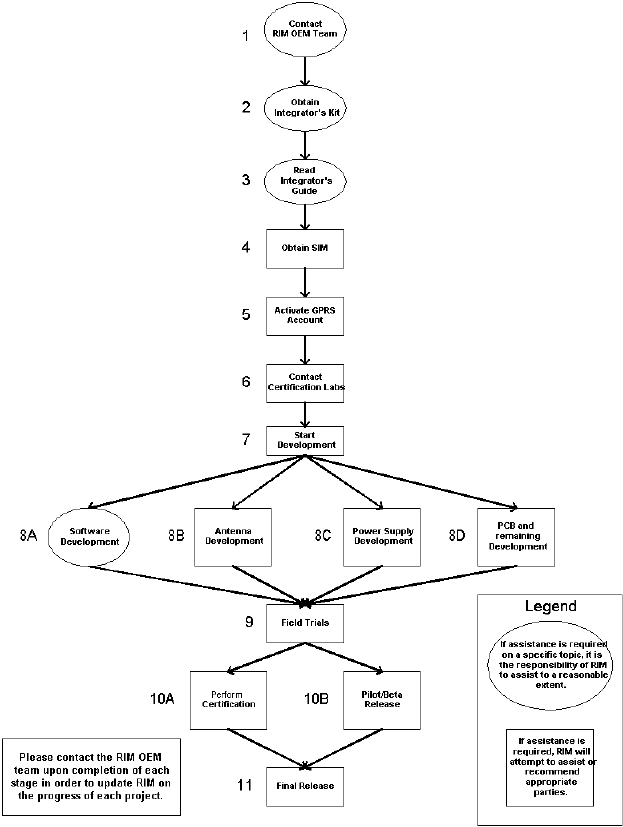
Chapter 3: Getting Started
18 RIM GPRS Radio Modem
Integration overview
The following flowchart illustrates the integration process.
Integration overview
Integrator Guide 19
Contact the RIM OEM team
Email OEMinquiry@rim.net or call (519) 888-7465 x5200 to obtain more
information about RIM Radio Modem products and whether they are suitable for
your application.
Obtain Integrator's Kit
You can request the Integrator’s Kit from Research In Motion. This kit includes
the radio modem, a mechanical sample of the radio, an interface and test board,
AC to DC power supply, required cables, magnetic mount antenna, and
documentation.
Read the Integrator's Guide
Read the Integrator Guide first to ensure that you follow proper procedures to
prevent unnecessary delays and damage to equipment. This guide explains topics
such as mounting requirements, battery power characteristics, interfaces to the
RIM radio modem, and antenna selection and placement.
Obtain SIM
Contact the appropriate network provider to obtain a SIM card. For network
contact information, visit http://www.rim.net/oem or contact RIM at
oemsupport@rim.net.
Activate GPRS account
Contact the appropriate network provider to activate the GPRS account. For
network contact information, visit http://www.rim.net/oem or contact RIM
at oemsupport@rim.net.
Contact Certification Labs
Learn about obtaining FCC and/or Industry Canada certification. Radio
frequency (RF) emitting products cannot be sold in the United States or Canada
until you have the necessary government approvals. Understanding what you are
permitted to do before beginning your design can save redesign costs later on.
Chapter 3: Getting Started
20 RIM GPRS Radio Modem
For more information on testing, visit http://www.rim.net/oem/ or contact the
RIM at oemsupport@rim.net.
Start Development
Plan your project carefully before starting development. You must address several
important considerations when planning your design. To speed up the
development process, you can often perform several procedures in parallel.
Contact RIM at oemsupport@rim.net for further details.
Develop Software
RIM will help if you encounter any problems with the communication between
the offboard processor and the radio.
Develop an Antenna
Several antennas have been certified for use with the RIM radio modem. Refer to
the Integrator's Guide for details. If these antennas do not meet your needs, start
developing an antenna for use with the final product. Please refer to the
Integrator's Guide for guidelines on antenna development. In addition, contact
RIM for general assistance and for recommendations of antenna companies that
can provide further assistance.
Develop a Power Supply
Start developing the power supply for the product. Refer to the Integrator's Guide
for guidelines on the strict power requirements of the RIM radio modem. Contact
RIM at oemsupport@rim.net for further details on power requirements,
guidelines for power supply development, and recommendations of power
supply companies that can provide further assistance.
Complete PCB and Remaining Development
Start developing the housing and Printed Circuit Board (PCB) for the product.
Refer to the Integrator's Guide for guidelines on radio and antenna placement.
Integration overview
Integrator Guide 21
Conduct Field Trials
Start product field trials to ensure performance and reliability.
Perform Certification
Choose a testing lab to perform FCC or Industry Canada certification and any
applicable network certification. Before sending your product for testing, contact
RIM to ensure that the solution is set up properly for testing. For more
information, visit http://www.rim.net/oem/.
Pilot/Beta Release
Contact RIM prior to beta release of the product, especially if the product has not
been certified yet. There are very specific guidelines that must be followed to
ensure legality of the release prior to certification.
Final Release
Congratulations on having completed the development process! Contact RIM if
you encounter any obstacles related to the RIM radio modem. In addition, please
provide regular updates to RIM on the progress of the release.
Chapter 3: Getting Started
22 RIM GPRS Radio Modem

Chapter 4
Setting up the
test board
Test board overview
The RIM test board provides a standard RS-232 serial interface
between a computer and the radio modem. The test board helps
you interface the RIM GPRS Radio Modem to a standard
computer using a COM port or to a terminal device using a
RS-232 serial port. The test board also provides access points to
the radio’s communication port, which enables you to monitor
activity with a logic probe, multimeter, or oscilloscope.
The test board includes the following components and
functionality.
• RS-232 interface
• On/off switch
• test points
• power supply
•LED indicators
• standard SIM Slot
• microphone/speaker Jack
The test board functionality and components are described
below.
Chapter 4: Setting up the test board
24 RIM GPRS Radio Modem
RS-232 interface
The serial (COM) port on a computer and most terminal devices operates at
RS-232 signal levels, which are typically ±12V. This high voltage would damage
the RIM GPRS Radio Modem, which is typically integrated into a device that
operates an asynchronous serial port at 3.0V. The RS-232 interface on the test
board allows you to produce an output from the radio that is easily interpreted by
a PC.
On/off switch
When the switch is on, the radio turns on whenever power is applied to the test
board. When the switch is off, the radio shuts down. For more information, see
“Turning the radio on and off” on page 53.
Test points
The test board is more than just an RS-232 interface. It also features debugging
facilities to help you test your application. It provides direct access to each of the
22 pins on the radio interface cable, which enables connectivity to analytical
equipment—such as a logic probe, multimeter, or oscilloscope—and real-time
indication of data flow.
Power supply
The RIM GPRS Radio Modem requires a clean, high-current power source. RIM
uses a standard plug-pack to provide the current necessary to operate the radio.
The voltage is converted into the necessary levels by the power supply section on
the test board.
LED indicators
The test board includes several LED indicators designed to indicate the flow of
data to and from the host (in real time), the radio power status, power to the test
board, and more.
Connecting the test board
Integrator Guide 25
Standard SIM Slot
The test board includes a SIM slot for use with standard 3V SIM cards. The SIM
card is necessary in order to access GSM/GPRS networks.
Microphone/Speaker Jack
The test board includes a microphone/speaker jack for use with the headset
included in the Integrator's Kit. This allows the integrator to take full advantage
of the GSM circuit switched voice network underlying the GPRS networks.
Connecting the test board
You must connect the RIM GPRS Radio Modem to an antenna, SIM card, and a
computer, (or another device with a RS-232 serial interface). Use the test board
and cables supplied with your Integrator’s Kit.
Connecting the test board consists of the following tasks:
1. Connecting the test board to the radio
2. Connecting the SIM to the radio
3. Connecting the test board to the computer
4. Inserting the SIM card
5. Connecting the test board to an AC outlet
6. Connecting the antenna to the radio
7. Turning on the system
The tasks should be completed in the order shown above. They are described
below.
Connecting the test board to the radio
Use the 22-pin flat interface cable to connect the test board to the radio.
This interface cable carries most of the data, and all of the voice, between the test
board and the radio. Control and status signals such as ONI are also carried on
this cable. This cable also carries clean, regulated power to the radio.

Chapter 4: Setting up the test board
26 RIM GPRS Radio Modem
When you insert the cable, verify that the side with the bare pins is in direct
contact with the pin side of the connector. To ensure proper contact, do not force
the cable into the connector; instead, pull the tabs on either side of the connector,
slide the cable in, then push the tabs back in.
Connecting the SIM to the radio
Use the 6-pin flat SIM interface cable to connect the SIM slot on the test board to
the radio. The SIM interface cable carries all of the data and power between the
test board SIM slot and the radio modem.
When you insert the cable, verify that the side with the bare pins is in direct
contact with the pin side of the connector. For proper contact, do not force the
cable into the connector. Instead, pull the tabs on either side of the connector, slide
the cable in, and then push the tabs back in to tighten.
Connecting the test board to the computer
Use straight-through DB-9 serial cable to connect the test board to the computer.
Connect the male end of the cable to the test board. Connect the female end of the
cable to the computer’s COM port.
Inserting the SIM card
You must have a SIM card authorized for use by the appropriate GPRS network
provider. The authorization must also allow access to the Access Point Name
(APN) that will be targeted.
Slide the SIM card into the slot. Ensure that the leads on the board connect with
the conductive surfaces of the SIM card. The SIM card can only be installed one
way.
Note: This task only applies to the 1802G and 1902G models.

Connecting the test board
Integrator Guide 27
Connecting the test board to an AC outlet
Plug the 5VDC, 2.4A, center-pin-positive power adapter into the wall outlet.
Connect the other end to the power jack of the test board.
Connecting the antenna to the radio
The Integrator’s Kit includes a high-performance, 6 dB-gain magmount antenna,
which is terminated with a screw-on SMA plug. The radio modem includes a
snap-on MMCX jack.
Connect the antenna cable supplied with your kit from the antenna’s SMA plug to
the radio’s MMCX jack.
Turning on the system
Supply power to pins 7 and 8 on the radio modem to allow the radio modem to
power up. However, the power switch on the test board, which controls the
TURNON line, can also control whether the RIM GPRS Radio Modem is on.
When the radio is on, the LED marked ONI is lit. The radio can also be turned on
using software commands. Refer toRefer to "Chapter 7" on page 45 for more
information.
Note: The magmount antenna provides optimum RF performance when placed on a
broad metal surface, such as the roof of a car. When used inside a building, for improved
performance, place the antenna inear a window, with few obstacles, such as a wall,
furniture, or equipment, between the antenna and the window.
Chapter 4: Setting up the test board
28 RIM GPRS Radio Modem

Chapter 5
Integrating the
radio modem
This chapter explains how to determine the position of the
radio modem within an application, including the following
topics:
• environmental properties
• physical properties
• mounting methods
•connectors
Environmental properties
Environmental testing ensures that RIM products can
withstand both typical and extreme real-world conditions.
During environmental testing, RIM takes samples of its radio
modems and subjects them to a variety of harsh conditions.
Each unit in the sample is also visually inspected after testing.
This experience enables RIM to fine-tune its design and
manufacturing process.
Storage temperature
The RIM GPRS Radio Modem can be stored at a temperature
from -40°C to 85°C (-40°F to 185°F).

Chapter 5: Integrating the radio modem
30 RIM GPRS Radio Modem
Operating temperature
The RIM GPRS Radio Modem operates between -30°C to 70°C (-22°F to 158°F).
Physical properties
Weight
The RIM GPRS Radio Modem weighs 35 g (1.2 oz), including the case.
Dimensions
RIM radio modems meet stringent space requirements. The maximum
dimensions of the radio modem, not including cables, are:
• Width: 42.0 mm (1.65 inches)
• Length: 67.5 mm (2.66 inches)
• Thickness: 8.4 mm (0.33 inches)
Warning: The end user should be careful not to exceed the upper temperature limit, as
performance degradation or damage to the power amplifier can occur past this point,
especially during transmission.
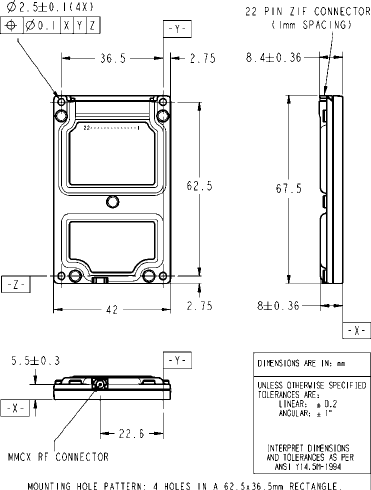
Mounting methods
Integrator Guide 31
Mounting methods
RIM radio modems can be securely fastened using a variety of methods. You
must consider the operating environment when choosing a mounting option. For
example, extreme temperature, heavy vibration, or high electromagnetic
interference areas can require a special mounting solution. You must ensure that
the radio modem remains securely attached in the environment where it is used.
This section describes the following mounting methods:
• bolts or standoffs
• tie wraps
• permanent industrial adhesive
The following information is presented as a guide; however, applications can vary
considerably. A mechanical engineer can help to ensure that the mounting
method is suitable for the specific application.
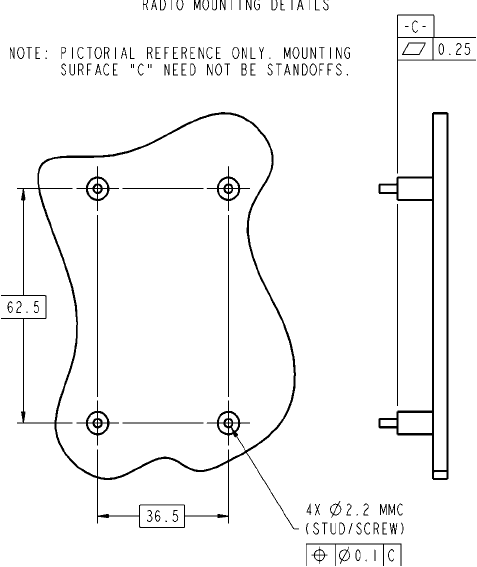
Chapter 5: Integrating the radio modem
32 RIM GPRS Radio Modem
Bolts or standoffs
The radio modem includes a hole in each corner, which can be used to bolt the
device onto a circuit board, device housing, standoffs, or other surface. The
mounting hole pattern is four holes in a 62.5-by-36.5 mm rectangle, with each hole
2.5 mm in diameter.
To allow room under the radio for components on your board, you can use
standoffs instead of bolts, as illustrated in the following diagram.
Cables and connectors
Integrator Guide 33
Tie wraps
Tie wraps can be used as a secure but non-permanent means of attaching the
radio modem to a surface. Typically, each tie wrap passes through a hole drilled
into the surface of the board, on either side of the radio modem. This enables the
radio to be attached to a shell, a PCB, or some other mounting surface.
If you are using tie wraps, ensure that the surface beneath the radio modem is flat.
Otherwise, the mounting surface can push up on the bottom surface of the radio
case, and the tie wraps, when tightened, can push down on the edge of the radio
case. This pressure can cause the metal case of the radio modem to flex upward
and to short components inside the radio. To avoid such malfunction, you should
not use thick adhesive foam tape and tie wraps together.
Permanent industrial adhesive
The RIM GPRS Radio Modem is small and lightweight enough to be attached to
the host device using an industrial adhesive. For some applications, this
mounting method is preferable to bolts, because adhesive is easier to use in a
manufacturing environment and is more resistant to loosening than bolts. In
many cases, an effective solution is to adhere the radio modem to the inside
surface of your product’s casing.
Choose an adhesive based on its ability to stick to the material used in the outer
casing of the radio modem and to the surface to which the radio will be mounted.
The RIM GPRS Radio Modem’s bottom casing is magnesium.
3M manufactures VHB, a permanent industrial adhesive with excellent long-term
holding power. The peel adhesion and tensile holding power of VHB tapes are
extremely high, making this a suitable solution when the radio does not need to
be removed. Choose foam tape for rough surfaces and adhesive tape for smooth
surfaces.
For information about VHB, contact 3M Industrial Tape and Specialties Division
at 1-800-227-5085 (fax: 1-612-733-1771). The publication number for the VHB
technical data sheet is 70-0702-0266-1(104.5)R1.
Cables and connectors
The radio modem has the following connectors:
• radio interface connector

Chapter 5: Integrating the radio modem
34 RIM GPRS Radio Modem
• SIM interface cable (G models only)
• antenna connector
Radio interface cable and connector
The radio interface connector connects the radio modem to a serial computing
device, speaker and microphone, and power supply. Serial communication data,
control signals, and power are carried on a flat 22-conductor 0.30 mm (0.012
inches) thick flexible printed circuit (FPC) cable with 1-mm centerline spacing,
which can plug into a matching connector.
Because each application is unique, it may be necessary to create a custom Flat
Flex Cable (FFC) Jumper with the correct length and correct connector orientation
for your application. Please refer to the diagram in the next section for FPC
specifications.
The interface cable supplied with the Integrator’s Kit is a Type D 76.2 mm (3.0
inches) long FFC Jumper with 1 mm centerline spacing, Molex part number
210390382.
This cable can plug into a matching 22-position 1.0 [0.039] horizontal FPC
connector. AMP/Tyco Electronics manufactures a variety of connectors. For
information about each connector, including mechanical drawings, visit the
manufacturer’s web site (www.amp.com), or contact RIM (oemsupport@rim.net)
for help selecting an appropriate connector for your application.
SIM interface cable and connector
The SIM interface cable and connector connects a SIM card to the radio modem.
All SIM communication data and power are carried on a flat 6-conductor 0.30 mm
(0.012") thick flexible printed circuit (FPC) cable with 1.00 mm centerline spacing,
which can plug into a matching connector.
Because each application is unique, it may be necessary to create a custom Flat
Flex Cable Jumper with the correct length and connector orientation for your
application. Please refer to the following diagram for FPC specifications:
Note: The SIM interface cable and connector are only required for the 1902G and 1802G
models.
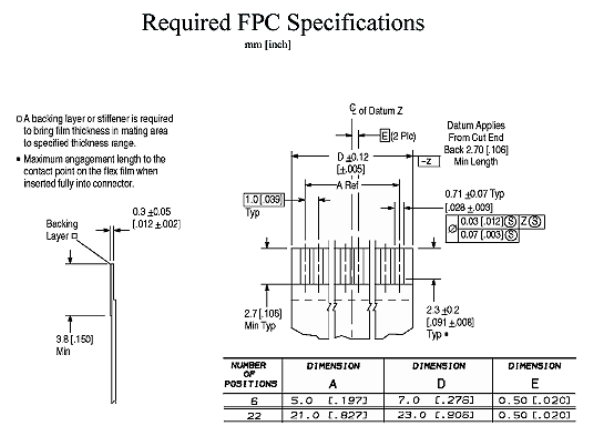
Cables and connectors
Integrator Guide 35
The 6-pin interface cable supplied with the RIM GPRS Radio Modem Developer's
Kit is a 76.2 mm (3.0") long Flat Flex Cable (FFC) Jumper with 1.00 mm centerline
spacing and same side conductive surfaces, Parlex part number 100-6-76-B.
This cable can plug into a matching 6-position 1.0 [0.039] horizontal FPC
connector. A variety of connectors are manufactured by AMP/Tyco Electronics,
including AMP part number 487951-6. For information about each connector,
including mechanical drawings, visit the manufacturer's web site
(www.amp.com), or contact RIM (oemsupport@rim.net) for help with selecting an
appropriate connector for your application.
Chapter 5: Integrating the radio modem
36 RIM GPRS Radio Modem
Contact:
Antenna cable and connectors
The antenna cable and connector connects the antenna to the radio modem. RIM
uses the industry-standard MMCX connector for the RIM GPRS Radio Modem.
The MMCX connector is very small, and it has the mating force to withstand
heavy vibration.
Typically, an antenna does not plug directly into a RIM GPRS Radio Modem.
Instead, a cable is used between the radio’s antenna connector and a second
connector at the outer casing of the device. This allows the antenna to be removed
from the system without opening the device, and it eliminates a source of strain
on the radio’s MMCX connector.
The antenna cable should have low loss, an impedance of 50 Ω, and an MMCX
jack that mates with the RIM GPRS Radio Modem’s MMCX plug. The other end of
the cable can be any connector with an impedance of 50 Ω. An SMA screw-on
connector is suitable and widely available. TNC connectors are also suitable, but
Amp / Tyco Electronics
General Information
Harrisburg, PA, USA
tel: (800) 522-6752
fax: (717) 986-7575
www.amp.com
Molex Headquarters
Lisle, IL, USA
Tel: (630) 969-4550
Fax: (630) 969-1352
email: amerinfo@molex.com
http://www.molex.com
Molex Electronics Ltd.
Toronto, ON, Canada
Tel: (416) 292-1444
Fax: (416) 292-2922
Parlex Corporation
Flexible Circuits Products
Methuen, MA, USA
tel: (978) 685-4341
fax: (978) 685-8809
email: flexcircuits@parlex.com
www.parlex.com
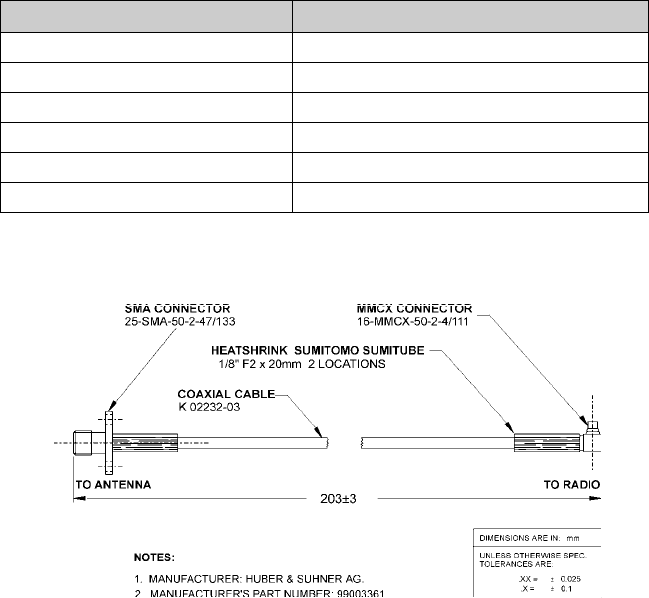
Cables and connectors
Integrator Guide 37
larger than SMA. The antenna cable supplied with the Integrator’s Kit has an
MMCX connector on one end and an SMA connector on the other. The cable is
built with strain reliefs to prevent damage.
Huber & Suhner provides antenna cables and connectors. The parts described
below have an impedance of 50 Ω and are suitable for use with the RIM GPRS
Radio Modem.
The following cable is included with the Integrator’s Kit:
Part number Cable or connector
11MMCX-50-2-1C/111 Straight MMCX connector
16MMCX-50-2-1C/111 Right-angle MMCX connector
25SMA-50-2-25/111 SMA connector
EZ Flex 405 Low-loss matching (50 W) cable
133REEZ4-12-S2/1216 8” cable, straight MMCX to SMA
133REEZ4-12-S2/1699 8” cable, right-angle MMCX to SMA
Chapter 5: Integrating the radio modem
38 RIM GPRS Radio Modem
Contact:
Huber & Suhner
Essex Junction, VT, USA
Tel: (802) 878-0555
Fax: (802) 878-9880
http://www.hubersuhnerinc.com
Huber & Suhner
Kanata ON, Canada
Tel: (800) 627-2212
Fax: (613) 596-3001

Chapter 6
Power
Requirements
The RIM GPRS Radio Modem requires a clean power source
capable of delivering bursts of high current. This power source
can be provided by a plug-in power supply unit, a rechargeable
battery pack, or by single-use batteries.
Load specifications
The RIM GPRS Radio Modem draws its power in bursts; the
power required changes rapidly depending on whether the
radio is transmitting, receiving, or idle.
Power supply parameters
Preliminary indications are that the RIM RIM GPRS Radio
Modem requires a clean, stable 3.5 to 4.75 volt source that is
capable of delivering a one-second burst of up to 2 A when
required by the transmitter. Final numbers are yet to be
determined. RIM recommends designing a more robust power
supply that can provide adequate power under such non-ideal
conditions as an improperly matched antenna, under which
this burst could be as high as 2.2 A.

Chapter 6: Power Requirements
40 RIM GPRS Radio Modem
For the RIM GPRS hardware integration to be fully compatible with the RIM
902M and RIM 802D radio modems, ensure the power input to the radio modem
is above 4.1 Volts. Please contact the RIM OEM Engineering Development team
for further details on backwards compatibility.
Ripple specification
For best performance, ripple of less than 15 mV peak-to-peak (measured at the
radio end of the connector) is recommended across the frequency range 60 Hz to
1 MHz. The maximum ripple at the connector that can be tolerated is 20 mV
peak-to-peak.
Except in special cases where there are several sources of ripple, measure the
ripple with an oscilloscope set to 1-MHz bandwidth; the peak-to-peak value is not
to exceed 15 mV.
You can place a passive LC (series L, shunt C) power filter between your power
supply and the RIM radio modem to reduce ripple at the radio connector. The
radio modem already has approximately 70 µF of on-board shunt capacity. The
inductor cannot exceed 100 µH (otherwise, transients could reset the radio), it
must be rated to pass the maximum DC current of 2.2 A supply current at all
temperatures, and its resistance must be low enough to guarantee minimum
voltage of 3.5 V to the radio modem at 2.2 A.
Batteries
When integrated into a handheld device, the RIM GPRS Radio Modem can be
powered by batteries. This technology is easily available and eliminates the need
for power supply components such as voltage regulators.
Note: If there are several ripple components, or if ripple is measured with a larger
(typically 20-MHz) bandwidth, the ripple seems worse. If the ripple is still below 15 mV
under these conditions, it meets the ripple specification.

Batteries
Integrator Guide 41
Rechargeable batteries
Nickel cadmium
RIM recommends using rechargeable nickel cadmium (NiCad) batteries to power
the RIM GPRS Radio Modem for battery-operated applications that require a
wide operating temperature range. Nickel metal hydride (NiMH) and lithium ion
(Li+) cells can also be used with good results, but many such cells do not work
very well at temperatures below freezing. Batteries specifications should be
obtained from the manufacturer.
The selected cells must be able to meet the radio modem load specifications.
Specifically, they must be able to provide 2.0 A (at 4.2 V) for transmission.
Rechargeable cells vary considerably, because capacity varies with current draw.
Even if two cells have the same published capacity, one might not be as efficient as
another when the radio transmitter is turned on. This is because some batteries
have a higher equivalent series resistance (ESR) at high current drain. The ESR
should be low enough that the battery can supply the transmission current
required without a large voltage drop.
Alkaline
You can also use rechargeable alkaline batteries. These cells are typically rated for
about 25 discharge cycles, far fewer than NiCads, but they provide longer life
than NiCads. For the first five to ten cycles, you will receive about 70 to 80 percent
of the battery life you would expect from a single-use alkaline cell. After 25
discharges, this number may drop to 50 percent.
Warning: You must take precautions with alkaline rechargeable batteries. These cells
are not intended to be used to their full capacity, so their actual useful runtime is closer
to 30 to 40 percent of a single-use alkaline cell, and requires the user to pay closer
attention to the state of the batteries. If you fully discharge a rechargeable alkaline
battery, you may only get five recharges before the capacity decreases to the point
where it is useless.

Chapter 6: Power Requirements
42 RIM GPRS Radio Modem
Single-use batteries
Among single-use cells, only alkaline and lithium cells provide the high current
necessary for transmission. In particular, AA alkaline cells are inexpensive,
widely available, and provide an excellent power source. Alkaline cells typically
run about four times longer than similar-size NiCad cells, and about three times
longer than similar-size NiMH cells.
Plug-in supplies
A plug-in supply converts normal AC power (usually 110 V or 220 V) into a
steady DC source that can be used instead of batteries. The plug-in supply must
be designed to ensure that voltage spikes, lightning, and other power fluctuations
cannot damage the radio modem. Transient voltage protection zener diodes, or
other spike arrestor circuits, can be added to keep the inputs within the limits
given in the radio modem load specifications. These should have a value of 20 V
and be placed on the supply side of the regulator circuit.
Preliminary indications suggest a supply capable of providing at least 3.5 V and
rated for 2.2 A peak current is recommended. Final numbers are yet to be
determined.
Automotive supplies
If you plan to power the RIM GPRS Radio Modem from an automotive supply,
you must take steps to protect the radio modem from intense power fluctuations
that occur when an automobile is started. A circuit comprising inductors,
transorbs and voltage regulators should be used to ensure that the radio modem
is protected from these power fluctuations.
Warning: The use of general-purpose carbon-based batteries is strongly discouraged;
this type of battery is unable to supply the power required by the transmitter. These
cells are more suited to flashlights and other products that do not have a load
characteristized by bursts. If a carbon-based battery is used, the voltage drops below
the minimum power required under load almost immediately following a radio
transmission, which resets the radio each time it tries to transmit.
You should recommend to users of your product to use single-use batteries that are
clearly identified as alkaline.
Automotive supplies
Integrator Guide 43
Commonly, in automotive applications, voltages may be as high as 70 V on the
battery, especially on startup. Commercial automotive adapters are available that
safely convert the 12 V automotive supply to a regulated supply suitable for
operating the RIM radio modem.
Chapter 6: Power Requirements
44 RIM GPRS Radio Modem

Chapter 7
Interface
specification
The asynchronous serial interface on the RIM GPRS Radio
Modem operates at 3.0V, making it compatible with many
existing system designs.
The radio modem can be controlled by a wide variety of
microcontrollers and microprocessors, such as the Intel 8051 or
80386, or Motorola 68000. In most cases, the RIM GPRS Radio
Modem can be connected directly to a micro-controller, or
through a Universal Asynchronous Receiver/Transmitter
(UART) to a microprocessor data bus. If the radio modem will
be connected directly to a PC or other RS-232 device, an
interface must be provided to convert the signal voltage to the
higher values required by an RS-232 device.
The RIM GPRS Radio Modem is compliant with GSM Phase
2/2+ specifications. For detailed information on the AT
command structure, please refer to the
RIM GPRS Radio Modem
AT Command Reference Guide
included in the Integrator's Kit.

Chapter 7: Interface specification
46 RIM GPRS Radio Modem
AT Commands
SIM Interface Pins
This section describes the purpose of each of the 6 lines that comprise the SIM
interface to the 1902G and 1802G radio modems. All SIM Interface lines are 3.0
volt logic. The 1902G and 1802G radio modems' software polls the SIM card to
confirm its presence.
Command Description
V.25ter The V.25ter commands correspond to the basic commands of
AT Hayes-compatible modems applicable for GSM 07.07.
Examples of such commands include answering incoming
calls, switching modes, and redialling.
GSM 07.07 The GSM 07.07 commands are for remote control of GSM
functionality, including phone book functionality. Example of
such commands includes selecting bearer service types,
entering PIN's, and changing passwords.
GSM 07.05 for SMS The GSM 07.05 commands are for performing SMS and CBS
related operations for both Text and PDU modes. Examples of
such commands include deleting, transmitting, and saving
SMS messages.
GSM 07.07 for GPRS The GSM 07.07 for GPRS AT commands are required for all
GPRS functionality such as PDP context definitions and
activations, QoS definitions and requests, GPRS attaches and
detaches, PDP address retrieval, GPRS Mobile Station class
retrieval, event reporting, network registration status retrieval,
and SMS messaging services.
Note: The SIM interface Pins only apply to models with off-board SIM cards.
Note: For proper operation, the SIM connector cable should be no more than 10cm
long.
The VPP line on the SIM card connector can be shorted with the VCC line to continue
proper operation.
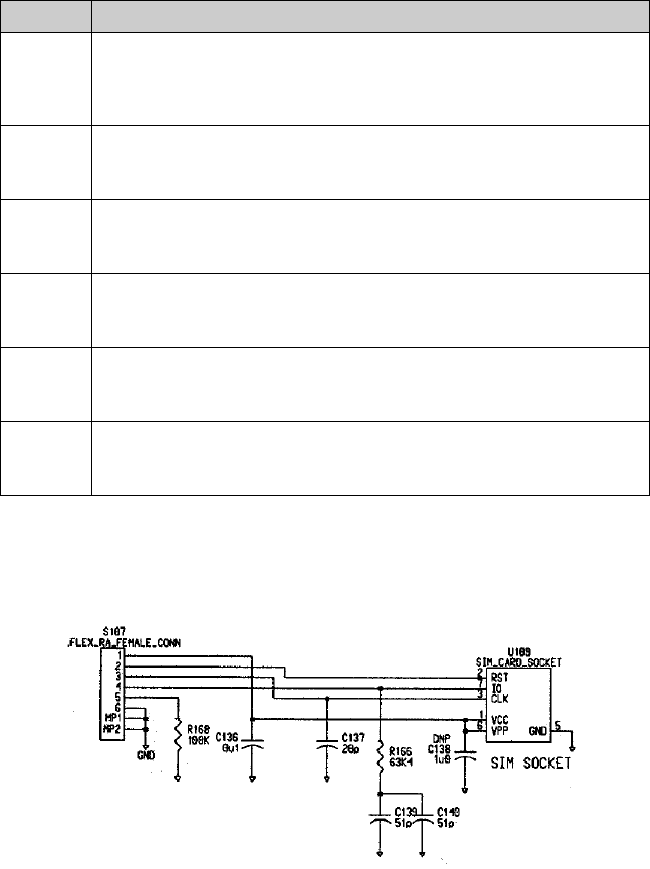
SIM Interface Pins
Integrator Guide 47
The following diagram shows an example of how the SIM was incorporated onto
the RIM Integrated Test Board:
Pin Description
1VCC.
This line supplies the SIM with power. Verify that it leads to the VCC pin of the SIM
card connector. It may be necessary to filter noise on the line to prevent a fault
from occurring. Please refer to the diagram in the next section as an example.
2 Reset.
This is an output from the radio. Verify that it leads to the Reset pin of the SIM
card connector.
3Clock.
This is an output from the radio. Verify that it leads to the Clock pin of the SIM
card connector.
4 Input/Output.
This is a bidirectional line between the SIM card connector and the RIM GPRS
OEM radio modems. Verify that it leads to the I/O pin of the SIM card connector.
5SIM Detect.
The active state of this line is high. This line should be asserted in order to ensure
the radio modem can detect the SIM card.
6Ground.
This is an input to the radio. Short this line to the GND pin of the SIM card
connector.

Chapter 7: Interface specification
48 RIM GPRS Radio Modem
Radio Interface Pins
This section describes the purpose of each of the 22 lines that comprise the radio
interface to the RIM GPRS Radio Modem.
Overview
Pins 1-4
Pins 1 to 4 were introduced to take advantage of the GPRS data network’s
underlying GSM voice infrastructure. The differential nature of the analog lines
provides high voice quality and noise immunity.
Pins 5-22
Input and output lines from pins 5 to 22 are 3.0 volt logic; however, they will also
be able to drive 3.3 volt systems. Input lines 16, 19, 20, and 22 are 5.0 volt input
tolerant. Output lines will be capable of driving 5.0 volt systems provided the
VIH of these pins is less than 2.5 volts.
All digital outputs will source a short circuit current of 3 mA. Digital Inputs will
have a current leakage of 1 mA.
Serial ports
There are two serial ports on the RIM GPRS Radio Modem.
• The primary serial port uses pins 20 and 21 for transmit and receive and is
used to carry AT commands and data between the radio modem and the
computing device.
• The secondary serial port uses pins 13 and 22 for transmit and receive and
may be used only by a custom application that resides on the radio modem
itself, never AT and data traffic. Flow control lines are provided for the
primary serial port only.
Note: Pins 5 to 22 are identical to those of the RIM 802D/902M.

Radio Interface Pins
Integrator Guide 49
Pin descriptions
The following table lists each pin and describes it in detail.
Note: The symbol ~ before the label indicates that line is an active low digital signal.
Pin Label Description
1 MIC N This pin is not used in this release.
2 MIC P Analog Microphone Input
This is an analog input to the radio.
3SPK NAudio Ground
This is an analog reference signal for pin 2 and pin 4.
4SPK P Speaker Signal.
This is an analog speaker output from the radio.
5 MSG Message Waiting
This line is a digital output from the radio.
The active state of this line is high, and indicates that the radio
modem has received a packet, which has not been delivered to the
device application yet, from the network. This line remains active until
the application acknowledges receiving the packet.
When the radio modem receive buffer is full, this line is inactive (low).
6COV Coverage
This line is a digital output from the radio.
The active state of this line is high, and the radio modem is in network
coverage, as determined by the presence of a signal from the network
base station.
When the radio modem does not have contact with the wireless
network, this line is low.
7, 8 — Power supply
These pins supply power to the radio. Since the current requirement
during transmission exceeds the current rating of a single line, both
lines 7 and 8 should be connected to the power supply. Supplying
power to these two lines allows the radio to turn on.

Chapter 7: Interface specification
50 RIM GPRS Radio Modem
9GND Ground
This line should be tied to the system ground of the computing device
to ensure proper operation. Pin 18 should also be connected to
ground.
10 TURNON Turn Radio On
This line is an input to the radio.
This line turns on the radio unit. It is a digital signal that eliminates the
need for an on/off switch for the power supply to the radio modem.
This is a 3.0 V input to the radio, and is not 5.0 V tolerant.
Please note that the functionality of the TURNON line can be
performed through AT commands as well. Refer to "Turning the radio
on and off" on page 53 for more information.
11 ONI On Indicate
This line is a digital output from the radio that indicates that the radio
is on and operational.
This line can be used by a computing device to qualify the
handshaking outputs on the serial interface. If CTS is low, and ONI is
high, then the unit is ready to receive data, but if CTS is low and ONI is
low, then the radio modem is not ready to receive data because it is
off.
When ONI is low, all inputs to the radio modem should be held low or
disconnected. Otherwise, power is consumed and wasted.
12 TRI Transmit Indicate
The active (radio transmitting) state of this line is high.
This output from the radio modem is asserted while the radio is
transmitting a packet to the network base station. TRI has a built-in
current limiter that enables it to directly drive an LED , which provides
real-time visual feedback that the radio is transmitting packets. If this
is not necessary, you can leave the line disconnected.
This line supplies 3 mA to a standard LED, and is short-circuit
protected. This line is low when the radio modem is off.
13 RX2 Secondary Receive
This line is an input to the radio modem. Its idle (no serial transmit
activity) state is high.
This line is an asynchronous serial output from the radio modem, and
may be connected to a computing device's Transmit Data output. This
line carries data at a maximum of 115 200 bits per second, 8 bits, No
parity, 1 stop bit.
This line is meaningful only as part of a debug port primarily for RIM
internal use.
Pin Label Description

Radio Interface Pins
Integrator Guide 51
14 ~RI ~Ring Indicate
This line is an output from the radio modem.
When ~DTR is not asserted (high), the radio modem asserts ~RI (low)
to indicate that it has data waiting for the computing device. The
radio modem does not transfer the data until ~DTR is asserted (low).
This line can be used to wake up a suspended computing device
when the radio modem needs to communicate with it. If ~DTR is
already asserted (low) when the radio modem has data to send the
computing device, ~RI is not asserted.
15 ~CTS ~Clear To Send
This line is a digital output from the radio modem to the computing
device. The active (clear to send) state of this line is low.
When asserted low by the radio modem, this line indicates that it is
ready to receive data from the computing device. While this line is
high, any data sent from the computing device to the RIM GPRS Radio
Modem may be lost. This line is a flow control mechanism that is
normally reacted to by the UART in your serial communication system.
If you do not plan to use it, leave ~CTS disconnected.
16 ~RTS ~Request To Send
This line is an input to the radio modem. The active, request to send,
state of this line is low.
This line should be asserted low by the computing device to indicate
that it is ready to receive data from the radio modem. This is a flow
control mechanism that is normally handled by the UART in your
serial communication system. If you do not connect this line to your
UART, it must be tied low so that it is permanently asserted and
enables communication.
If your device buffer overflows, it should set RTS inactive to signal the
radio modem to pause sending data. There might be a 16-byte
overrun after the RTS line is made inactive, so your device should set
RTS inactive at least 16 bytes before any critical buffer overflows.
17 ~DSR ~Data Set Ready
This line is a digital output from the radio modem.
The active, data set ready (DSR), state of this line is low. Your
computing device can use DSR as a confirmation that the radio
modem knows the state of the terminal. DSR follows DTR, so the two
lines are always at the same voltage.
18 GND Ground
This line should be tied to the system ground of the host unit to
ensure proper operation. Pin 9 should also be connected to ground.
Pin Label Description

Chapter 7: Interface specification
52 RIM GPRS Radio Modem
19 ~DTR ~Data Terminal Ready
This line is a digital input to the radio.
The active, data terminal ready (DTR), state of this line is low, and
indicates that the computing device is ready to receive data from the
radio modem. De-asserting this line high turns communication off;
the radio modem does not attempt to deliver data to the computing
device until ~DTR is again asserted low.
If you do not intend to use ~DTR, tie it to ground to ensure that it is
always asserted during radio modem operation.
This line should be driven low when the radio modem is off. Driving
~DTR high when the radio modem is off will consume unnecessary
power.
20 RX Receive
This is an input to the radio. Its idle (no serial receive activity) state is
high.
This line is an asynchronous serial output from the radio modem, and
should be connected to the host terminal's Receive Data input. This
line carries data at a maximum of 115 200 bits per second. Parameters
are 8 bits, No parity, 1 stop bit. This baud rate can be changed using
the proper AT command.
21 TX Transmit
This line is an output from the radio modem. Its idle (no serial receive
activity) state is high.
This line is an asynchronous serial output from the radio modem, and
should be connected to the host terminal’s Transmit Data output. This
line carries data at at a maximum of 115 200 bits per second.
Parameters are 8 bits, No parity, 1 stop bit. The baud rate can be
changed using the proper AT command.
22 TX2 Secondary Transmit
This line is for RIM internal use only.
Warning: All unused inputs to the radio should be tied to ground, and any unused
outputs from the radio should be left disconnected.
Pin Label Description
Turning the radio on and off
Integrator Guide 53
Turning the radio on and off
To determine the current state of the radio, observe the ONI line. If ONI is high,
the radio is on or in the process of shutting off. If ONI is low, the radio is off or in
the process of turning on. The TURNON pin is a digital signal that turns the radio
on and off. It eliminates the need for a power switch across the power supply to
the radio. There are also AT commands that can turn the radio on and off in the
same manner as the TURNON line.
Turning the radio on
There are two ways to turn the radio on. Either set TURNON to high, or transmit
the appropriate AT command through the serial communications port.
During the startup procedure of the RIM radio modem, which can take several
seconds, all AT commands and changes to TURNON will be ignored by the
operating system.
Do not use theTURNON to indicate radio status. ONI must be used as the
indicator of the radio status. It is possible for the radio to be off even though
TURNON is asserted. In this case, the radio can be turned on through the
appropriate AT command, or by setting TURNON low and then high again.
If the radio fails to respond to a high TURNON line or the proper AT command,
the radio may require service or the power supplied to the radio may be too low
for proper operation.
Turning the radio off
A controlled shutdown of the RIM radio modem is necessary. There are two ways
to turn the radio off. Either de-assert TURNON, or transmit the appropriate AT
command through the serial communications port.
During the shutdown procedure of the RIM radio modem, which can take several
seconds, all AT commands and changes to TURNON will be ignored by the
operating system.
Do not use the TURNON state to indicate radio status. ONI must be used to
indicate radio status. It is possible for the radio to be on even though TURNON is
de-asserted. In this case, the radio can be turned off through the appropriate AT
command, or by setting TURNON high and then low again.

Chapter 7: Interface specification
54 RIM GPRS Radio Modem
Data that has been received by a RIM GPRS Radio Modem from the network, but
has not been transferred to the computing device, will not be saved. The data will
be lost when the unit enters shutdown or is turned off.
It is not necessary to remove power from pins 7 and 8, unless the application is
very power constrained.
Resetting the Radio
It is recommended that integrators incorporate a method to remove power from
pins 7 and 8 on the radio modem during the development and prototype phase.
This will enable the device to perform a hard reset of the radio modem, which can
be useful in some debugging testing situations.
Loading firmware (optional)
RIM firmware controls the operation of the radio modem. RIM is committed to
the quality of its firmware, and improvements or optimizations may be made
from time to time. The radio modem is designed so that loading revised firmware
is not required; two RIM GPRS radio modems with different firmware revisions
will always be able to communicate with each other, and with the same fixed
servers, through the wireless network. Nevertheless, you may choose to design
your application in such a way that allows the RIM firmware to be updated after
your product is deployed in the field.
Because of its large size, firmware cannot be updated over the air. If you decide to
implement the ability to update the firmware after the radio modem is deployed,
RIM can provide a command-line programming utility that loads firmware into
the radio modem. If your device is not MS-DOS-based, the programming utility
must reside on a PC or laptop that is connected through its COM port to the radio
modem’s RX and TX lines. This means that the RX and TX lines would be brought
out to an external connector, and a switch required to select whether the radio
modem is connected to your processor or to the external programming computer.
Other lines that are required during reprogramming are DTR (must be asserted
low), TURNON (must be asserted high), and GND.
Note: All inputs to the radio should be low when the radio is turned off. This ensures
that power consumption will be reduced to the lowest possible levels.
Loading firmware (optional)
Integrator Guide 55
This external serial port can also be useful for FCC certification testing, and it is
highly recommended that this be incorporated into at least one device designated
for testing purposes.
Chapter 7: Interface specification
56 RIM GPRS Radio Modem

Chapter 8
Antenna
selection
The antenna is one of the most important components of a
wireless communication system. The right antenna will
maximize the coverage area of the RIM radio modem.
The antenna that you choose should suit your project’s needs.
There are many different antenna types and options that will
meet your engineering and user requirements and remain
within budget constraints. We strongly recommend the use of
an experienced antenna provider in order to realize the highest
gain possible. A well-designed antenna solution will maximize
efficiency, coverage area, and battery life.
Selecting an antenna
Antenna manufacturers have designed and manufactured a
wide variety of antennas for use on the GPRS network, and for
other radio-frequency (RF) systems operating in the same
frequency range. RIM does not recommend specific antennas
because the choice of antenna is application-dependent.
The performance of an antenna depends on its configuration
and environment; the same antenna will behave differently
from device to device, even if these devices use the same RIM
radio modem. For example, magmount antennas include a
magnetic base that allows the antenna to clamp onto a metal
surface. This surface is called a ground plane, and it reflects
Chapter 8: Antenna selection
58 RIM GPRS Radio Modem
electromagnetic radiation that would otherwise be lost to the antenna. This
reflection effectively doubles the length of the antenna by creating a virtual
“mirror image” of the antenna beneath the plane.
Antenna requirements
The following are the minimum requirements of the antenna system used with
the RIM GPRS radio modems. Further minimum requirements are pending.
Ffor the RIM GPRS Radio Modem hardware integration to be fully compatible
with the RIM 902M and RIM 802D radio modems, the antenna must be modular.
GPRS has several frequency bands, 1900, 1800, 900, and 850, each of which
requires its own antenna. Additionally, GPRS, Mobitex, and DataTac networks
have different center frequencies. If the same antenna is used for all three
networks, receiver sensitivity is greatly affected. Please contact the RIM OEM
Engineering Development team for further details on backwards compatibility.
The RIM GPRS Radio Modem requires an impedance of 50 Ω .
Introduction to antenna terminology
This section introduces some of the terminology that is used to describe antennas,
and expands on the summary of antenna requirements, above.
Gain and ERP
Antennas produce gain by concentrating radiated energy in certain areas, and
radiating less energy in other directions. The amount of gain depends on the
radiation pattern, antenna match, and antenna efficiency. Antenna gain is given
as a rating of the maximum increase in radiated field energy density relative to a
dipole antenna, expressed in decibels of power gain (dBd).
A dipole is a balanced antenna consisting of two radiators that are each a
quarter-wavelength, making a total of a half-wavelength. The widespread use of
half-wave dipole antennas at VHF and UHF has led to the use of a half-wave
dipole as the reference element.
At the antenna port, the output power of the RIM GPRS Radio Modem is as high
as 1.0 W at the antenna port. The antenna gain (or loss) results in an increase (or
decrease) in this value. The actual output from the antenna is called the Effective

Introduction to antenna terminology
Integrator Guide 59
Radiated Power, or ERP. For example, if the radio modem delivers 2.0 W of power
to a 2.3 dBd gain antenna, the ERP is 2.0 ×10^(2.3÷10) = 3.4 W, the actual power
radiated by the antenna in the direction of maximum gain and polarization.
Impedance matching, return loss, and VSWR
The antenna, cables, and connectors in a radio frequency system must all possess
the same impedance. The impedance required by the RIM GPRS Radio Modem is
50 Ω, which is a widely-available industry standard. Any deviation from this
value may result in impedance mismatch and signal loss.
Impedance mismatch can also be caused by cable connections, cable lengths, and
imperfections in the cables and connectors. The mismatch causes some of the
radio frequency energy to be reflected back from the mismatch location. This
reflection interferes with the signal and reduces its amplitude, which results in
power loss.
Antenna mismatch can be expressed as a Return Loss (RL), which is the ratio of
reflected power to the incident power, expressed in decibels.
Equation 1: Return Loss
The Voltage Standing Wave Ratio (VSWR) is another way to express the ratio of
incident power (from the radio modem) to reflected power (into the radio
modem).
Equation 2: VSWR
VSWR = 1 or RL = -∞dB is a perfect match. In practice, imperfections are
inevitable, which means that VSWR will be greater than 1 and RL will be a
negative number.
RL =×
10 10
log P
P
reflected
output
VSWR =
+1P
P
1 - P
P
reflected
output
reflected
output
Chapter 8: Antenna selection
60 RIM GPRS Radio Modem
VSWR and RL normally vary as a function of frequency.
Antenna size
The optimal antenna radiation efficiency is produced by an antenna measuring
one wavelength, l. The value of l for the RIM GPRS Radio Modem is calculated by
dividing the speed of light c = 3 x 108 m/s by the center frequency.
Antenna lengths of λ/2, λ/4, and λ/8 also work well, and usually result in a
relatively well matched antenna. λ/2 or λ/4 can be electrically “shortened” by
adding load matching elements to control the antenna match. However, this
shortening will reduce the antenna efficiency and, therefore, the effective radiated
power.
Antenna design considerations
Proper antenna positioning maximizes the gain provided by the antenna. When
you determine the proper position, consider the environment in which the device
will be used. Physical devices can vary significantly, and incorporating the
antenna is an integral part of a successful design.
When you are designing an antenna, you should consider the following issues:
• vertical polarization
• proximity to active electronics
• transmit interference
•device position
• antenna cable
These issues are discussed below.
Vertical polarization
The GPRS network is based on vertically polarized radio-frequency transmission.
Therefore, the antenna should be oriented to provide vertical polarization. This
polarization is achieved by positioning the antenna vertically upward when the
Antenna design considerations
Integrator Guide 61
radio modem is in use. In small, hand-held devices, it may be convenient to
design the unit in such a way that the antenna folds out of the way when not in
use.
Proximity to active electronics
The antenna should be located as far from the active electronics of the computing
device as possible. In general, metal construction in the case of the computing
device and its internal components may attenuate the signal in certain directions.
This is not desirable because it reduces the sensitivity and transmit performance
of the radio modem when the computing device is held or positioned in certain
orientations. However, the judicious use of metal in the construction of a ground
plane for an antenna can significantly improve the antenna gain and the system’s
coverage.
Transmit interference
To prevent interference from the antenna into the radio modem during transmit,
the antenna must be placed a minimum 2 cm (0.8”) away from the radio modem.
For best performance, the antenna should be placed more than 5 cm (2”) away
from the radio modem.
Device position
• If the computing device is designed to sit on a surface, the antenna should be
as far from the bottom of the device as possible. This reduces radio-frequency
(RF) reflections whenever the device is placed on a metal surface.
• When the computing device is hand-held or is worn next to the user’s body,
the antenna should be positioned to radiate away from the body. Otherwise,
the body absorbs the radiated energy and the effective coverage area of the
radio is reduced. Positioning the antenna away from the body also helps the
device meet the FCC’s RF exposure (SAR/MPE) requirements.
Chapter 8: Antenna selection
62 RIM GPRS Radio Modem
Antenna cable
For best results, the antenna should be connected directly to the antenna cable. If
you require an extension cable, it should be low loss, as short as possible, and
have an impedance of 50 Ω.. You must use a proper matching connector because
each connector in the signal path introduces a return loss and reduces
performance.
Additional notes
The following additional notes are provided courtesy of Larsen Antenna
Technologies:
“There are a number of critical issues to consider when integrating antennas into
portable RF systems. It is important to make allowances early in the design
process to optimize performance and provide flexibility in antenna choice.
Generally, it is prudent to position the antenna “up and away” from the radio
modem and printer motors to maximize noise reduction and receiver
desensitivity. Other “high noise” areas to be avoided include displays and
keypads that can seriously degrade antenna performance. Advances in antenna
shielding techniques may also be incorporated to retain the integrity of the
system.
“Mechanical issues for an integrated antenna revolve around proper cable routing
and use of service loops to provide uninhibited antenna rotation if needed. The
ability to position the antenna in a manner which will result in antenna
deformation, impact resistance and aesthetic requirements must also be
considered to design a workable form factor. The option to position the antenna
vertically when in use so that performance is optimized is another consideration
which can be limiting and a true consideration when choosing to use off-the-shelf
solutions.
“Custom antenna solutions may be worthy of consideration for some projects. In
some applications, custom designed antennas have shown performance increases
of up to 2 dB when compared to quality off-the-shelf solutions. The cost of a
custom design and resulting production can be as cost efficient as an off-the-shelf
solution for projects requiring quantities as low as 20,000 antennas. “The use of
state-of-the-art antenna theory, printed circuit technology, and application of
evolving concepts can produce antennas with reduced sized without
compromising performance.

Shielding
Integrator Guide 63
“Examining the options available, and choosing an antenna early in the
development process, can only benefit the performance and aesthetic appeal of a
product. The engineering staff at Larsen Antenna Technologies are experts in this
field with over 30 years of experience in helping OEMs reach their antenna design
and production objectives.”
Shielding
The electrical design of the RIM GPRS Radio Modem provides high immunity to
radio-frequency (RF) noise, also called electromagnetic interference (EMI). The
metal casing also acts as a shield to help minimize the effect of RF interference
originating from the computing device to which it is attached, and to prevent the
RIM radio modem from emitting RF energy into the computing device and
disrupting the computing device’s operation.
Consequently, you do not need to provide any additional RF shielding between
the radio modem and a computing device, unless the environment contains an
extreme level of RF noise (electromagnetic interference). In fact, it would be of
greater benefit for the power supply to the radio modem to be free of
high-frequency electrical noise, than to provide additional RF shielding.
The antenna must be positioned in such a way that the radiated energy is directed
away from the computing device. If this positioning is not possible, then RF
shielding may be required between the antenna and the computing device.
Note: Circuits with a high impedance, and sensitive analog circuits, are especially
vulnerable to nearby radio frequency emissions, and may need to be shielded. Circuits
like CRTs and LCD display drivers are typically affected.
Chapter 8: Antenna selection
64 RIM GPRS Radio Modem

Chapter 9
Specifications
The following is a summary of the RIM GPRS radio modems
specifications.
Power supply & typical current
usage
Preliminary values. Final values are yet to be determined
• Single power supply; operating range: 3.5 to 4.75V DC
• Transmit mode: up to 2 A (at 4.2V, output 1.0W)
RF properties
• Transmit frequency: 1850 to 1910 MHz and 824 to 829 MHz
• 1.0 W nominal maximum transmit power at antenna port
• Receive frequency: 1930 to 1990 MHz and 869 to 894 MHz
• Transmitter can reduce output power when near a base
station as per GSM specifications
• Preliminary receiver sensitivity: -107 dBm at 2.4% error rate
(BER)
• Multislot Class 8
Serial communications
• 3.0V asynchronous serial port
Chapter 9: Specifications
66 RIM GPRS Radio Modem
• Second 3-wire serial port (TX, RX, GND)
• Link speed: 1200 to 115,200 bps
Other features
• ARM Processor running at 32.5 MHz
• Software can activate/deactivate radio
• Flow control options: Hardware, Xon/Xoff, or None
• Radio parameters stored at power down
• Terminal devices may power-down while radio-modem remains operational
• Fully shielded metal enclosure
Mechanical & environmental properties
• Weight: 35 g (1.2 oz), including case
• Footprint: 42.0 by 67.5 mm (1.65" x 2.66")
• Thickness: 8.4 mm (.33")
• 3.0V interface connectors: 22 pin FPC (Flexible Printed Circuit) connector and
6 pin FPC connector
• Antenna cable connector: MMCX
•Metal case
• Preliminary operating temperature: -30°C to +70°C (at 5-95% relative
humidity, non-condensing)
• Preliminary storage temperature: -40°C to +85°C

Chapter 10
Glossary

Chapter 10: Glossary
68 RIM GPRS Radio Modem
Term Meaning
APN Access Point Name. GPRS network provider's name for a given
external network.
CBS Cell Broadcast Service. Unacknowledged general short messages to
all receivers within a defined geographical area
dB Decibel measures power based on a logarithmic scale. 10 dB = 10
times, 3 dB = 2 times, –10 dB = 0.1 times.
FPC Flexible Printed Circuit. The interface cable on the RIM GPRS Radio
Modem is made using this type of flat multi-conductor wiring. Also
known as FFC (Flat Flex Cable).
Gain In this document, refers to increase/decrease in radiated power.
GMSK The modulation scheme used by airlink communication on GPRS
communication. Allows theoretical data rates of 14.4 kbps per
timeslot.
GPRS General Packet Radio Service. The IP-based data network that
supplements the existing GSM voice networks throughout the
world.
GSM Global System for Mobile Communications. A second generation
voice communication network standard accepted throughout the
world.
IP Internet Protocol. Standard network layer protocol used over many
networks including the GPRS network and the Internet.
MMCX The connector on the RIM GPRS Radio Modem to which an antenna
cable is connected.
Network Operator The corporation or agency that installs, maintains and authorizes
use of a GPRS network in a given area, usually within one country.
Noise Undesired, random interference combining with the signal. If the
device is not immune to noise, the interference must be overcome
with a stronger signal strength. Noise can be produced by
electronic components.
OEM Original Equipment Manufacturer. Usually implies that the “OEM
product” carries another manufacturer’s name. The RIM GPRS Radio
Modem is designed to be embedded in OEM terminals, PCs, and
data gathering equipment.
OSI The Open Systems Interconnection model allows different systems,
following the applicable standards, to communicate openly with
each another.

Integrator Guide 69
Polarity Direction of current flow. Connecting some cables with the wrong
polarity (i.e. backward) may damage the device.
QoS Quality Of Service.
Radio Modem A device that provides
mo
dulation and
dem
odulation for a radio
frequency communications system.
Radiation In this document, refers to electromagnetic energy emitted in the
radio frequency (RF) band.
Return Loss A measure of antenna matching.
RF Radio Frequency.
RS-232 The standard asynchronous serial communications interface used
by most existing personal computers and mini-computers. Usually
refers to both the communications protocol and the electrical
interface.
RSSI Received Signal Strength Indicator. A high RSSI represents a strong
signal received by the radio modem from the base station.
SIM Subscriber Identity Module. A SIM is necessary in order to activate a
GSM/GPRS device on the network.
SMS Short Message Service. Messaging services over the
circuit-switched GSM networks, up to a maximum of 160
characters.
TTL Transistor-Transistor Logic. Used in digital circuits. Low (0) is
represented by 0 V and High (1) by 5 V. The RIM RIM GPRS Radio
Modem uses 3.0V for High.
UART Universal Asynchronous Receiver/Transmitter. Used as an interface
between a microprocessor and a serial port.
VSWR Voltage Standing Wave Ratio. A measure of antenna matching.
Refer to "Antenna selection" on page 57 for more information.
Term Meaning
Chapter 10: Glossary
70 RIM GPRS Radio Modem
Integrator Guide 71
Index
A
antenna
gain, 58
return loss, 69
shielding, 63
VSWR, 59, 69
C
cables
serial, 34
I
interface
connecting to, 34
test board, 24
UART, 69
M
mounting
permanent, 33
N
noise
shielding, 63
O
OEM, 68
P
power supply
alkaline batteries, 42
automotive supplies, 42
load specifications, 39
plug-in supply, 42
R
RS232, 69

© 2002 Research In Motion Limited
Produced in Canada